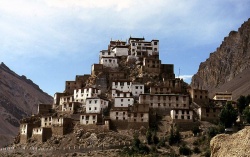Key Monastery
Key Gompa (also spelled Ki, Kye or Kee) is a Tibetan Buddhist Monastery located on top of a hill at an altitude of 4,166 metres (13,668 ft) above sea level, close to the Spiti River, in the Spiti Valley of Himachal Pradesh, Lahaul and Spiti district, India. It is the biggest Monastery of Spiti Valley and a religious training centre for Lamas. It reportedly had 100 Monks in 1855.
History
Key Gompa is said to have been founded by Dromtön (Brom-ston, 1008-1064 CE), a pupil of the famous Teacher, Atisha, in the 11th century. This may however, refer to a now destroyed Kadampa Monastery at the nearby village of Rangrik, which was probably destroyed in the 14th century when the Sakya sect rose to Power with Mongol assistance.
Key was attacked again by the Mongols during the 17th century, during the reign of the Fifth Dalai Lama, and became a Gelugpa establishment. In 1820 it was sacked again during the wars between Ladakh and Kulu. In 1841 it was severely damaged by the Dogra army under Ghulam Khan and Rahim Khan. Later that same year suffered more damage from a Sikh army. In the 1840s it was ravaged by Fire and, in 1975, a violent earthquake caused further damage which was repaired with the help of the Archaeological Survey of India and the State Public Works Department.
The walls of the Monastery are covered with paintings and murals, an example of the 14th century monastic architecture, which developed as the result of Chinese influence.
Key Monastery has a collection of ancient murals and Books, including Buddha images.
There are three floors, the first one is mainly underground and used for storage. One room, called the Tangyur is richly painted with murals. The ground floor has the beautifully decorated Assembly Hall and cells for many Monks.
Key Gompa now belongs to the Gelugpa sect, along with Tabo Monastery and Drangtse Monastery, one of three in Spiti.
- "The Monastery of Kee, for instance, accommodates nearly 250 Monks, who reside within the sacred walls in winter, and stay during the summer with their Parents or brothers, working in the fields, or employed in carrying travellers' goods. These Monasteries have their regular heads, or abbots, and the higher ecclesiastical titles can only be obtained by the candidates proceeding in person to either Shigatzee (Shigatse) or Lhassa (Lhasa)."
A celebration of its millennium was conducted in 2000 in the presence of the Dalai Lama.
